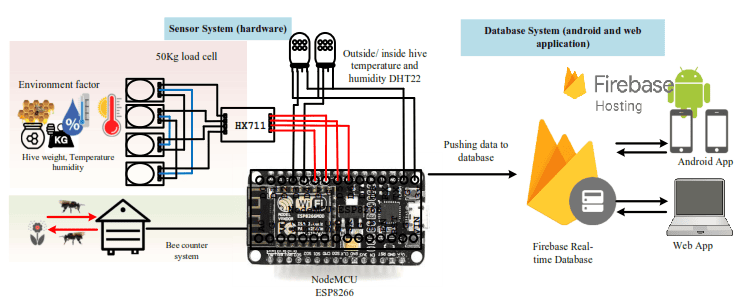An assessment of stingless beehive climate impact using multivariate recurrent neural networks

Noor Hafizah Khairul Anuar, Mohd Amri Md Yunus et.al.
School of Electrical Engineering, Universiti Teknologi Malaysia, Skudai, Malaysia
Vol. 13, No. 2, April2023, pp. 2030~2039
Key research conclusions:
Beehive climate data can be used to monitor the health of bee colonies. This paper assesses stingless beehive climate data and examines a precise short-term forecast model for hive weight output. The dataset was extracted from a single hive for approximately 36 hours, at every seven seconds time stamp. The results show that there is a strong correlation between hive weight and other climate variables, such as inside temperature, inside humidity, outside temperature, outside humidity, the dewpoint, and bee count.
The proposed forecast model uses seven input vectors to predict hive weight: hive weight, inside temperature, inside humidity, outside temperature, outside humidity, the dewpoint, and bee count. Two different network architectures were examined for minimal root-mean-square error (RMSE): long short-term memory (LSTM) and gated recurrent units (GRU). The LSTM1X50 topology was found to be the best fit for forecasting hive weight.
The results of this study indicate that monitoring beehive climate data can be used to identify unusual symptoms in bee colonies. This information can be used by beekeepers to make decisions to improve the health and propagation of their colonies.

More Points
● Beehive climate data can be used to monitor the health of bee colonies.
● This paper assesses stingless beehive climate data using Electronic Meliponini Advanced System (EMAS) and examines a precise short-term forecast model for hive weight output.
Why it is important to monitor beehives
Bees are important pollinators and play a vital role in the ecosystem. However, bee populations have been declining in recent years due to a number of factors, including climate change, habitat loss, and disease. Monitoring beehives can help beekeepers identify problems early on and take steps to improve the health of their colonies.
Some of the benefits of monitoring beehives include:
● Early detection of problems: By monitoring beehives, beekeepers can identify problems early on, such as pests, diseases, or nutritional deficiencies. This allows them to take action to address the problem before it has a significant impact on the colony.
● Improved colony health: By monitoring beehives, beekeepers can identify factors that are affecting the health of their colonies, such as poor nutrition or inadequate water supply. This information can be used to make changes to improve the environment of the hive and improve the health of the colony.
● Increased pollination: Healthy bee colonies are more productive pollinators. By monitoring beehives, beekeepers can ensure that their colonies are healthy and productive, which can help to increase pollination and improve crop yields.
Overall, monitoring beehives is an important way to help ensure the health and productivity of bee colonies. By monitoring beehives, beekeepers can identify problems early on, take steps to improve the environment of the hive, and increase pollination.
- Kunjungan Balas ke Ladang Kelulut MyHoney di Taman Impian Emas
- Sambutan World Bee Day 2025 Kebangsaan Indonesia | Lebah dan Madu: Sumber Nutrisi, Kesihatan dan Kelestarian Alam
- Kursus Jinak Ternak Lebah Kelulut – Raih Ilmu dan Pengalaman di Ladang Kelulut 50 Ekar
- TrigonaGold Madu Kelulut Itama + Tongkat Ali
- Penghasilan Tut Pokok Golden Penda untuk Kelulut








